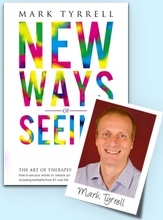
From depression to the self-medicating 'escapist' behaviours of chronic addiction, from acute anger and insomnia to relationship problems, stress is the cause and the outcome of so many seemingly insurmountable problems.
I once saw a boy having his hair cut. Well, that was the intention. But he kept moving his head from side to side. In order for the haircut to happen, he needed to stop moving his head.
I’ve had clients who were so acutely stressed they couldn’t really think. In order to do therapy, they had to stop and relax first. Only once we’d achieved the stillness of calm could we focus on overcoming their problems.
Sometimes it seems as though we swim in a sea of stress. (Sorry for all the alliteration!) Stress is on the increase,1 and uncontrolled stress harms us in all kinds of ways.
From depression2 to the self-medicating ‘escapist’ behaviours of chronic addiction, from acute anger and insomnia to relationship problems, stress is the cause and the outcome of so many seemingly insurmountable problems.
Physically, too, long-term stress – the gnawing sense that life’s problems are insurmountable, fear for the future, and constant worry – wreaks havoc on the body. Stress is implicated as a driver of heart disease,3 weakened immunity,4 autoimmune conditions such as allergies,5 accelerated ageing,6 and even dementia.7 And that’s by no means an exhaustive list.
So when you help diminish an ongoing stress response in your client’s mind and body, you directly enhance their wellbeing, health, and happiness. You may even save their life.
So how can we help our chronically stressed clients?
Step one: Relax!
The antidote to excessive stress is, of course, relaxation. Most emotional problems result from excessive stress caused by overwhelming circumstances and/or by faulty pattern matching within the client, which is in turn caused by emotional conditioning.
In other words, patterns of reality are matched to patterns of emotional response, which disempowers the client to choose how they respond. For example, a phobia is a faulty pattern match whereby the client matches a neutral object or situation to a response of extreme fear.
But before we reach the point of helping our stressed client change their response, and perhaps also their life circumstances, we may need to do some emergency destressing.
Someone recently asked on a Q&A call whether they should spend the whole first session taking information from a client and nothing else. I suggested that, to my mind, this may miss an opportunity to:
- build rapport with the client to help them relax with you
- instil hope by showing them they can feel different
- help calm the anxious mind enough to actually get useful information and form encouraging goals.
Whether it’s through your skilled teaching of breathing techniques, the more advanced skill of clinical hypnosis, or simply your calming demeanour, with really stressed clients the first step is to help them be calm enough to receive further therapy. Remember the boy in the barber shop – he needed to be still before he could receive his haircut.
But we also might need to deal with the stress of the stress.
Step two: Normalize the stress
“I feel like I’m really weird. Crazy!”
This client had just described an array of typical stress symptoms, such as insomnia, poor concentration (“I can’t think!”), loss of sex drive, and loss of appetite. She spoke of “not feeling real” and feeling “disconnected” from people and surroundings. So she had two problems: the original chronic stress, and the further stress of worrying that she was going crazy.
By helping our clients feel better about feeling stressed, we can immediately lower their stress.
Now when we talk about ‘normalizing’ clients’ problems, we don’t mean minimizing their impacts. It’s more about understanding and accepting those impacts. Some clients are frightened by the diverse and sometimes extreme symptoms of stress. Simply contextualizing these symptoms can be immensely reassuring, at least for some clients. When we treat anxiety, part of that treatment is helping clients see wider contexts.
So I might say something like:
“All those symptoms you’ve described can seem really worrying. But they’re only ‘symptoms’ when seen from one perspective. From another they’re responses and, in the right time and place, useful ones.”
We can then describe what stress actually does to the mind and body and why it needs to do that.
“When confronted with a real threat, such as a lion eyeing you with gustatory interest, certain responses within us get switched on and some get switched off.”
In the context of this situation, these are not symptoms – they are perfectly reasonable responses. A symptom only becomes a symptom when it hangs around too long.
So, in an emergency, rapid heartbeat, fast breathing, and increased energy get switched on fast. But what gets switched off?
Responses that are switched off
Encountering a lion is a short-term survival crisis, which means that we don’t require many of our long-term survival functions, such as:
- Digestion and salivation. You shouldn’t be eating lunch while you’re trying to avoid being lunch, so blood flow gets shunted away from your stomach and your mouth gets dry.
- Sex drive. You don’t need to be sexually excited when fleeing a lion (trust me, it won’t help!), so sex drive gets switched off during the stressful episode.
- Immune response. Fighting off little pathogens in your bloodstream is of little use if you’re being eaten by a lion, so your immune response takes a break.
- Intelligence: There’s no time to wax intellectual when you’re under attack, so the thinking brain takes a back seat.
- Sleepiness: A sudden emergency has a way of getting you really awake!
So all these adaptations are great… in the short term. However, if after two minutes either you or the lion has not cleared off, your adrenals will start producing the long-term stress hormone cortisol – and that’s what produces the symptoms of stress. Over time all adaptations, including suppressed immunity, sex drive, digestion, and sleep, become ‘symptoms’. On top of that, your blood pressure stays high, putting you at risk of hypertension and heart disease in the long term.
So we can understand the ‘symptoms’ of stress in this way. While acute stress can help us survive, it’s when chronic stress keeps these short-term responses switched on or off for too long that we start to have problems.
The ‘symptoms’ of stress – raised blood pressure, exhaustion, loss of sex drive, even digestive problems like IBS – are actually adaptive and essential functions that are outstaying their welcome. Even the feeling of derealization is a survival response: in the very short term it may give us the objectivity and ‘distance’ we need to act in ways that help us survive.
The problem is, for many of us, even after that lion is out of sight, it is never out of mind. Because we are imaginative creatures (well, most of us), we internalize the lion. We let it inhabit us and track us long term, stalking us through our dreams and daytime ruminations.
And of course, the stressor needn’t be a hungry lion. It may be an unhappy marriage or working life, a dire financial situation, or a bereavement we can’t come to terms with.
Whatever our client’s life circumstances, we need to help them limit how much time they spend scaring themselves in their heads.
Step three: Help them think less
Actually, when people say “I tend to overthink” I suspect they often mean they tend to overimagine.
The more time people spend misusing their imaginations to scare themselves, the more stress and depression they experience.8 When dealing with stress, we have to help clients spend less time ruminating so they don’t tip into depression.
We can teach our clients to think in ways that are less simplistically bleak, as it’s been found that ruminating with hope mitigates the depressive effects of excessive rumination.9 So if your client is naturally prone to spending lots of time in their head, you can at least help make it a nicer place for them.
We can use hypnosis, mindfulness training, and ‘behavioural activation therapy‘ to help our clients focus outward more. These five proven behavioural interventions for depression are also great ways to help your clients feel safer and so less stressed.
Mind you, many stressed clients will also need help reducing real stressors in their lives.
Step four: Divide and conquer
According to Anton Chekhov, “Any idiot can face a crisis – it’s day to day living that wears you out.” And, up to a point, he had a point.
To be stressed, we need a stressor. But that stressor needn’t be real: it can also be self-generated through the imagination.
It’s easy to fall into the trap of believing that people who are highly stressed must have huge problems in their lives. But a person can easily become stressed without any massive problems – and often the feeling that they have no good reason to be stressed only makes them even more stressed.
Certainly the acute, severe stress of conditions such as PTSD needs to be treated fast in order to destress the sufferer. But it’s all the little stresses, added together, that blight millions of lives.
When you notice that someone is favouring rumination and worry over activity and effective problem solving, that’s a warning sign that stress is overwhelming them. Perhaps they suffer from learned helplessness and don’t even know they can effect change in their lives, or maybe they have never learned effective problem-solving strategies.
Having multiple problems can feel overwhelming. So rather than breaking them down and dealing with them, our clients may fall into escapist patterns of procrastination or even addiction.
One cause of stress is feeling powerless and out of control. By helping our clients find effective problem-solving strategies, we help them reclaim their autonomy.
When dealing with problems, we can help our clients break them down into more manageable bites. What is the worst problem? Can we deal with that first? Will dealing with one problem actually help to solve other problems? Let’s get strategic.
It can be helpful to divide stressors into two categories: those that are practically solvable, and those that are not. For practically solvable problems, we can look at generating possible steps to practically solve those problems.
But what about those problems that are not practically solvable? Perhaps the ‘problem’ is the way the client feels about a dead person, or the state of the planet. In these cases we can help ‘solve’ the problem by helping our clients reframe the situation and so stress about it less. Or maybe the problem is broader – perhaps the client has a generalized negative bias. Here, we can challenge that bias to help restore their faith in humanity.
Lastly, we need to see what clients are not getting in their lives that may be generating stress.
Step five: What is your client not getting?
We tend to assume that a stressor entails the presence of something (an irascible lion, an irate spouse, a final payment demand, an episode of Love Island), but of course the absence of fulfilment is also highly stress inducing.
Fulfilment of the needs for attention, security, intimacy, connection to community, and a sense of meaning, as well as all the other primal emotional needs, is a kind of nutrition. And when these needs remain unfulfilled, it causes a kind of hunger in our clients.
We don’t just suffer from physical hunger; we experience emotional hunger, too. Stress is a signal (like thirst or hunger) that we are not meeting an important emotional or physical need. But emotional needs can be harder to spot than physical ones. It can be harder to know we lack, say, attention than water.
So what might stress be signalling for your client?
What might your client not have enough of in their life? The ache of loneliness,12 for example, or the ennui of a sense of meaninglessness are both signals of needs unmet.
Exercise is wonderful for relieving stress,10 as is time spent in nature,11 and certainly we should be encouraging these powerful anti-stress activities. But in order to help your stressed clients, a central part of your problem solving must entail helping them meet their missing emotional needs.
Chronic stress can lead to all kinds of problems. But, paradoxically, a complete lack of stress can become… well, stressful.
It’s not all bad
Stress gets a bad rap, and so it should… for the most part. Excessive, unremitting stress kills enjoyment and sometimes people. But a certain type of stress may actually make you happy.
In the short term, stress hormones such as adrenaline and noradrenaline help us perform better and react faster. And sometimes we need some of that to add spice to what might otherwise be a dull life.
Manageable, thrilling, and motivating stress has been termed eustress. Eustress can be found in the satisfaction of a challenge surmounted, or a roller coaster ridden. It tends to be short term and manageable.
Eustress is ‘good stress’, and without it life can seem dull and meaningless. What’s more, manageable emotional stresses can make us stronger, just as the stress of physical exercise can strengthen our bodies.
As a byproduct of eustress, we can expect better self-esteem and personal confidence. And sometimes distress evolves into eustress as we develop our resources and grow to master challenges we once saw as threats.
Joy and meaning doesn’t come from constant peace (as some might assume), but from a manageable and interesting blend of peace and stress. Life, like a rainbow, needs colour. We thrive on a diversity of feeling, perhaps with a dash of action here, a small (hopefully!) sprinkle of distress there, much eustress, and plenty of destress.
The more we see problems as challenges, the better we can creatively adapt to and surmount eustress, and the less distress we will tend to have.
Train online with Mark
Practitioners can train with Mark Tyrrell in a range of therapeutic skills in our online classroom Uncommon U. See the full list of courses here.
Notes:
- https://news.psu.edu/story/618484/2020/05/07/research/middle-age-may-be-much-more-stressful-now-1990s
- https://www.webmd.com/depression/features/stress-depression#1
- https://www.sciencedirect.com/science/article/pii/0301051194900248
- https://link.springer.com/article/10.1007/s12026-014-8517-0
- http://citeseerx.ist.psu.edu/viewdoc/download?doi=10.1.1.472.8458&rep=rep1&type=pdf
- https://link.springer.com/article/10.14310/horm.2002.1217
- https://academic.oup.com/brain/article/133/8/2217/385486
- https://www.bbc.co.uk/news/magazine-24444431
- https://ijmhs.biomedcentral.com/articles/10.1186/1752-4458-8-53
- https://pdfs.semanticscholar.org/8ff3/42042fadae822972942df2be0af0b496c985.pdf
- https://journals.lww.com/nursingresearchonline/Abstract/1999/07000/The_Effects_of_Sense_of_Belonging,_Social_Support,.4.aspx
- http://willsull.net/resources/BratmanHamiltonDaily2012.pdf






